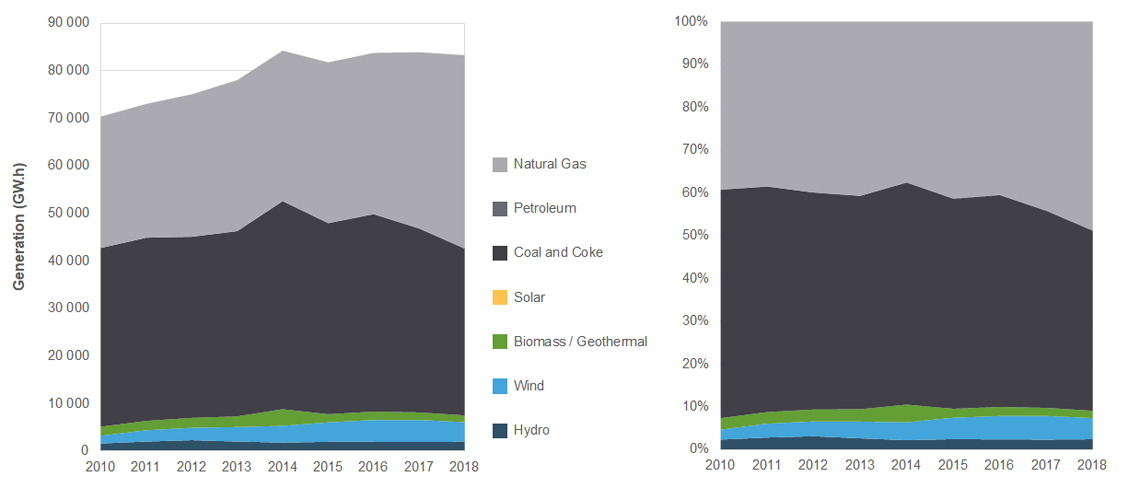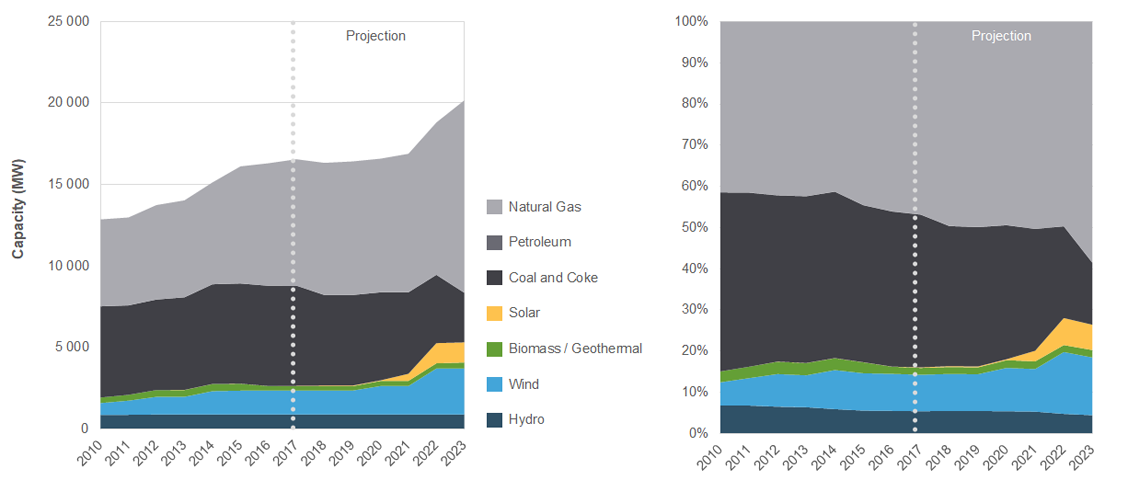Canada's Renewable Power – Alberta

Alberta

Fossil fuels generate most of Alberta’s electricity, but the province emerged over the past decade as a leading producer of wind energy in Canada. Between 2010 and 2017, Alberta’s wind capacity doubled. Wind capacity is projected to double again by 2023 as Alberta continues with its phase out of coal-fired generation.
Generation Trends
Electricity generation in Alberta has historically been dominated by coal and natural gas. In recent years, however, generation has shifted from coal towards more natural gas. Between 2010 and 2018, coal-fired generation declined from 37 567 gigawatts (GW.h) to 35 044 GW.h – from 53.4% of Alberta’s total generation to 42.1%. Over that same period, natural gas-fired generation grew from 27 595 GW.h to 40 579 GW h. Total thermal generation in 2018 was 75 739 GW.h, or 90.9% of total generation.
Alberta has a long history with wind energy. Commercial wind developments started in southern Alberta in the mid-1990s. Since 2010, wind generation in the province has more than doubled – from 1 629 GW.h in 2010 to 4 119 GW.h in 2018. Alberta also has some hydro and biomass facilities, and small, but growing generation from solar. Total renewable generation in 2018 was 7 538 GW.h, or 9.1% of total generation.
Total electricity generation in Alberta grew from 70 346 GW.h in 2010 to 83 277 GW.h in 2018. Changes in Alberta’s electricity generation mix are illustrated in Figure 1.
Figure 1. Electricity Generation in Alberta

Source and Description
Source: CER Canada’s Energy Future 2020 (EF2020)
Description: This graph illustrates electricity generation from 2010 to 2018 in Alberta. In 2010, Alberta’s total generation was 65 188 GW.h (7.3% renewable). In 2018, total generation was 83 277 GW.h (9.1% renewable).
GHG Emissions from Electricity Generation
In 2018, Alberta’s electricity sector emitted 36.2 megatonnes of carbon dioxide equivalent (MT of CO2e). Alberta’s generation intensity was 630 grams of CO2e per kilowatt-hour.
Alberta produced 52% of Canada’s total greenhouse gas emissions from electricity generation in 2018.
Recent and Projected Capacity Changes for Renewables
Between 2010 and 2017, Alberta added a net 718 megawatts (MW) of renewable capacity, primarily in the form of wind (744 MW). Alberta also had a net reduction of 68 MW of biomass capacity over this period. Between 2017 and 2023, Alberta is projected to add 1 990 MW of new net renewable capacity. These capacity changes are illustrated in Figure 2 with data provided in Table 1.
Recent and future projects included in the projection are:
- Whitla Wind 1, which added 202 MW in 2019.
- Whitla Wind 2, which is expected to add 97 MW in 2021.
- Sharp Hills Wind Farm, which is expected to add 249 MW in 2020.
- Castle Rock Ridge 2, a wind project that is expected to add 30.6 MW in 2022.
- Riverview Wind Farm, which is expected to add 97 MW in 2022.
- Cypress Wind Project, which is expected to add 202 MW in 2022.
- Stirling Wind Project, which is expected to add 113 MW in 2022.
- Buffalo Plains, a wind project that is expected to add 48 MW in 2022.
- Windrise Wind Project, which is expected to add 207 MW in 2022.
- Jenner Wind Power Project and Expansion, which is expected to add 194 MW in 2022.
- Brooks Solar, which added 15 MW in 2018.
- Claresholm Solar, which is expected to add 130 MW in 2021.
- Travers Solar, which is expected to add 465 MW in 2022.
- La Crete Biomass, which is expected to add 41 MW in 2020.
- Swan Hills Geothermal, which is expected to add 4 MW in 2021.
Over the medium term, no new growth is expected from hydro in Alberta. It is also expected that coal-fired capacity will continue to shrink while natural gas-fired capacity continues to grow. Between 2017 and 2023, coal capacity is projected to decline by 3 107 MW while natural gas capacity is projected to expand by 4 055 MW.
A notable capacity contraction occurred in 2016 when the Cowley Ridge wind facility was retired by TransAlta after 23 years of service. Cowley Ridge was Canada’s first commercial wind farm and had a capacity of 16 MW at the time of retirement.
Figure 2. Electricity Capacity and Future Changes in Alberta

Source and Description
Source: CER – EF2020
Description: This graph illustrates historical electricity capacity from 2010 to 2017 in Alberta and the CER’s projection of future capacity changes from 2018 to 2023. In 2010, Alberta’s total installed electricity capacity was 12 862 MW (15.1% renewable). In 2017, capacity had grown to 16 555 MW (16.0% renewable). By 2023, total capacity is projected to grow to 20 172 MW (26.4% renewable).
Table 1. Electricity Capacity (2010 – 2023) and Generation (2010 and 2018) in Alberta
| Capacity in MW and % | Generation in GW.h and % | ||||||
|---|---|---|---|---|---|---|---|
| 2010 | 2017 | 2018 | 2020 | 2023 | 2010 | 2018 | |
| ---------- Projected ---------- | |||||||
| Hydroelectricity | 874 | 894 | 894 | 894 | 894 | 1 620 | 1 991 |
| 6.8% | 5.4% | 5.5% | 5.4% | 4.4% | 2.3% | 2.4% | |
| Wind | 723 | 1 467 | 1 467 | 1 746 | 2 826 | 1 629 | 4 119 |
| 5.6% | 8.9% | 9.0% | 10.5% | 14.0% | 2.3% | 4.9% | |
| Biomass / Geothermal | 340 | 273 | 273 | 314 | 368 | 1 909 | 1 428 |
| 2.6% | 1.6% | 1.7% | 1.9% | 1.8% | 2.7% | 1.7% | |
| Solar | 0 | 21 | 36 | 36 | 1236 | 0 | 0 |
| 0.0% | 0.1% | 0.2% | 0.2% | 6.1% | 0.0% | 0.0% | |
| All Renewable Sources | 1 937 | 2 655 | 2 670 | 2 990 | 5 324 | 5 158 | 7 538 |
| 15.1% | 16.0% | 16.3% | 18.0% | 26.4% | 7.3% | 9.1% | |
| Coal and Coke | 5 591 | 6 143 | 5 555 | 5 400 | 3 036 | 37 567 | 35 044 |
| 43.5% | 37.1% | 34.0% | 32.5% | 15.0% | 53.4% | 42.1% | |
| Natural Gas | 5 327 | 7 750 | 8 100 | 8 193 | 11 805 | 27 595 | 40 579 |
| 41.4% | 46.8% | 49.6% | 49.4% | 58.5% | 39.2% | 48.7% | |
| Oil and Diesel | 7 | 7 | 7 | 7 | 7 | 27 | 116 |
| 0.1% | 0.0% | 0.0% | 0.0% | 0.0% | 0.0% | 0.1% | |
| All Thermal Sources | 10 925 | 13 900 | 13 662 | 13 600 | 14 848 | 65 188 | 75 739 |
| 84.9% | 84.0% | 83.7% | 82.0% | 73.6% | 92.7% | 90.9% | |
| All Sources | 12 862 | 16 555 | 16 332 | 16 590 | 20 172 | 70 346 | 83 277 |
- Date modified:
